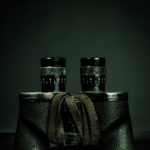
James Silas Rogers ’99 M.A. (Photos by Mike Ekern '02)
Not long ago, I went to an event where literary and minor celebrities gathered together to present awards to other writers. They dutifully read off the nominees’ names, and then opened the winner’s envelope with great fanfare: the same liturgy the Oscars follow.
One of the nicer touches in the ceremony was that the presenters were asked to say a few words in answer to the question, “What was the first grown-up book that had a powerful effect on you as a child?”
Some predictable choices: Mark Twain never fails, and To Kill a Mockingbird’s star still shines. But I liked the authors who pulled out the title of some obscure work, forgotten by most readers and, in reality, probably not that dazzling.
These were all exceptionally well-read people; I am certain that when asked to pick their one book, they were selecting from a list of hundreds. And after I thought about it a while, I realized, had I been asked, there was no question about my selection – and further, that my book was itself bound up with the whole experience of making lists: Roger Tory Peterson’s Field Guide to the Birds.
My copy was a gift I received on my 11th birthday. Every now and then I come across another copy of that edition, and at the sight of its green fabric cover embossed with a bobolink in flight, and its endpapers showing birds in silhouette, I wish I still had mine.
My Peterson’s stayed near me for a dozen years, until somewhere – in Wisconsin on the upper Apple River or the Namekagon, or maybe it was in Minnesota, on the Rum River or Cannon – it fell from a backpack into an inch of water sluicing around the bottom of a canoe. On unloading, I found it sodden. It took a week to dry out, and the pages were as wadded and stuck together as if dipped in a bucket of mucilage. I had to do something I almost never do: discard a book.
Even then it would have been easy enough to find another, and even then there were rivals to the title of “best bird book.” But, at that point, I felt I’d absorbed enough of the knowledge therein. Plenty of men can hear noises under the hood of a car and pronounce that the lifters are bad or the tappets are going; I envy them, sometimes – and I feel sorry for them if they don’t know how to tell a goldfinch in flight, or to distinguish a black-capped night heron from a green heron. Such information is at my instant recall.
Most of all, I never replaced my Field Guide because none of them could be my copy, the one I fitted out with color-coded index tabs (uselessly; I had no idea where to put them, and knew the book well enough not to need them anyway; but I felt it was a gesture that made me look like a serious birder).
And certainly no replacement could have had my life-list in the front.
The life-list: an adaptable idea. Those writers at the awards ceremony were doing something fundamental to the way we humans organize reality. One way to negotiate the profusion of all that surrounds us is to record it.
Homo album faciet: man, the list maker.

I started list-making by ticking off the birds in the front of my Peterson’s Field Guide. The book that I tossed in the trash had been with me beside a cattail swamp in Sibley County where my father had stopped to scout for duck hunting. A bird drew my eye: I brought out the binoculars. The twitch in the reeds became another check on the life-list, a short- billed marsh wren. I felt like Roger Tory Peterson himself would have been proud of me.
Other times, I think it was best nobody was watching. The truth is I fudged a bit on the life-list. Discerning between the wish and the fact, in birding or anywhere else, always presents a challenge. I don’t really think I ever saw an ovenbird. I guessed at half those sandpipers. Once I saw an oriole fly across the road at dusk, and though I knew the light was bad at best, maybe it was an orchard oriole – so I boldly, hopefully, checked it off.
But when I had the Field Guide in hand to confirm a spotting – field marks accounted for, similar species ruled out, the chance that this was within the usual range verified – there was solemn authority in the moment.
The book always came with me to the lake. “The lake” meant two summer weeks in July when my family would decamp to Alexandria, Minnesota, and take up a cabin. For 20 years we kept a tradition of swim and sunburn, fishing, minnow-seining and root beer floats at night.
And there were long afternoons when I would walk through the poplar grove behind the cabin, the ground a soft mulch of old tree roots, sphagnum, drying ferns. For years, I wondered what bird it was that made those endless, obscurely sad calls in the understory, whistles rising and falling in tone at the end. The eastern phoebe, Page 147, plate facing Page 155.
One of my favorite short stories is “The Weaver’s Grave” by the Irish writer Seumas O’Kelly: A masterpiece, “The Weaver’s Grave” hinges on a moment of epiphany for a young widow whose life changes when she is told to look for an elm tree. The knowledge that there are different sorts of trees, and the discovery that it is possible to discern one from another alters her way of being in the world. Right then, at the instant she realizes elm trees are different from other trees, she had “a clear insight into something that had up to this moment been obscure. And no sooner had the thing become definite and clear than a sense of the wonder of life came to her.”
Peterson’s was a 300-page guide to turning the general into the specific. Like the widow who’d known trees only in the collective, my knowledge of birds had been monolithic. Before Peterson’s, I had seen blackbirds: After, I saw grackles, divided further into the species of bronzed, purple and boat-tailed.
I had my copy with me when, as a 13-year-old I bicycled across the old swing bridge to Grey Cloud Island south of Newport, Minnesota, and stood at the base of a Mississippi River bluff watching a circling hawk hundreds of feet above. I brought that soaring hawk to me without needing to bring it to earth by turning to the black-and-white “Buteos and Harriers from Below” schematic. A red-tailed hawk – no great discovery, pretty much the Velveeta Cheese of birds of prey, but I didn’t know that then.
At the end of one of Paul Gruchow’s essays, he asks, “Can you imagine a satisfactory love relationship with someone whose name you do not know?” I guess we can try: Think of those personal ads that run, “Seen at the Lake Street Starbuck’s July 18 – you had on blue sundress, I was in a red T-shirt ...” If the advertisers ever do find their mark (something else to wonder about), any guess what the first information exchanged will be?
Nameless beauty troubles us. As Gruchow says in the same essay, “Names are passwords to our hearts, and it is there, in the end, that we will find room for a whole world.”
I was fortunate enough to have my Peterson’s Field Guide with me when, on an warm fall afternoon, I found myself among dozens of olive-drab birds in a willow thicket. The plate titled “Confusing Fall Warblers” made perfect sense of these faded migrants. It gave them a home in the book of names: Myrtle. Magnolia. Hooded. Yellow. Writing these down, checking these off, one recognizes the faintest tincture of an aboriginal joy that Adam first got to experience, that of naming the anonymous.
Our world is more whole when we know the names and ways of birds. And of flowers, and trees, and of the different varieties of lettuce, and so much else. To decline to learn such knowledge is to settle for a more loveless world.
Rogers edits New Hibernia Review and is director of the Center for Irish Studies. Three of his personal essays have been selected as a “notable” in the annual Best American Essays volumes, and his book about cemeteries, Northern Orchards: Places Near the Dead (North Star Press, 2014), was a finalist for the Minnesota Book Award in memoir and creative nonfiction. Rogers’ book of critical essays on Irish-American memoir will appear from Catholic University of America Press this fall.
Read more from St. Thomas magazine.









